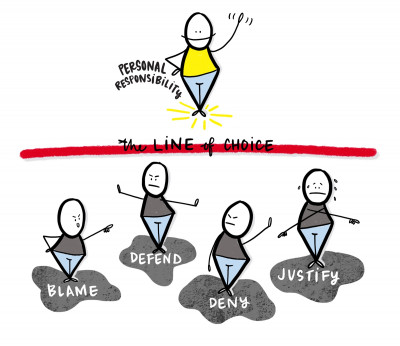When I ask people what they look for from an effective leader in their world of work, terms like ‘respectful’, ‘engaging’, ‘empowering’ and ‘has a positive impact’ often come up.
Notwithstanding the volumes and volumes of thinking and research about leadership and management that have been published over many years, for many of us, particularly in a workplace, leadership can be as simple as: respect who we are and the capability we bring and enable us to get things done and make things happen.
We know that when leaders operate above the line – choosing to take personal responsibility rather than instinctively reacting with blame, defensiveness, denial or justification – that this generates a sense of respect within a team. This, in turn, increases the discretionary effort that the team gives to their work. Ultimately, more is achieved.

What is not always recognised is the exponential effect that emotionally healthy leadership can have on strategic success. Research from the Leadership Circle shows that small improvements in a leader’s ability to operate above-the-line have a very large impact on that leader’s effectiveness. The converse is also true: below-the-line leadership quickly diminishes a team’s effectiveness, this time with an exponentially negative effect.
I doubt that any of this is a surprise to most readers. Most of us have experienced leaders who consistently operate above the line, and we know how rewarding it can be to work with such a leader. Most of us have also worked with leaders who consistently operate below the line, and we know how difficult and demotivating that can be.
Given the significance of effective leadership on an organisation’s success, it’s surprising how often we find leadership development in organisations is not at all aligned to strategic direction.
If we recognise that emotionally healthy leadership can have significant impact on productivity, discretionary effort and morale, it follows that developing emotionally healthy leaders can be a major driver for strategic success.
When this is acknowledged, this style of leadership development then becomes core to strategic direction rather than peripheral to it, or just something ‘good to do’.
It also becomes more than offering the type of competency-based opportunities that have typically been the core of many development programs, e.g. how to give and receive feedback or how to develop and implement a project plan.
When leadership development is aligned to strategic direction, its focus is on what drives and motivates leaders to do what they do, and the impact of that on themselves, others and the business.
When leadership development aims to increase emotional health, its focus is on how we engage all three centres in the decisions we make and the ways in which we engage and enable others as we make them. There is an emphasis on understanding the impact of our communication style/s and the effect they have in how messages are shared, understood and interpreted.
Emphasis is also given to understanding that vulnerability (particularly in relation to not knowing everything and being able to admit mistakes) can have a positive and lasting impact in the development of respectful relationships.
Anyone who has worked with an effective leader knows how much more effective that makes us and our team. When considering strategy, effective leadership – emotionally healthy leadership – should be the starting point, not an afterthought.
Gayle


Thank you for this article. One of the core steps of the emotionally healthy leadership process. The person has to understand their behaviours, automatic reactions and how they respond when situations come from outside.
Hugs